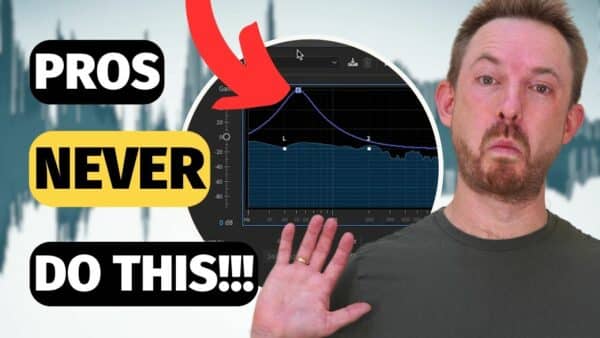Equalization (EQ) is an essential tool every audio enthusiast should know. If used properly it can improve the quality of audio projects. However, improper use can do more harm than good. In this blog post, I’ll share the 5 most common mistakes producers make when trying to EQ their projects. In addition, I will show you how to correct them and make your audio sound great!
What is EQ?
Equalization is the process of adjusting the frequency components of an audio recording. This involves boosting or cutting specific frequency ranges to enhance or reduce certain elements of the sound. This allows you to clear up muddy mixes, highlight important sections, and create a wonderful audio experience.
EQ Mistake #1: Over-boosting the Bass
The first EQ mistake is over-boosting the bass of your recording. It can be tempting to add as much bass because these frequencies provide the foundation and power for most audio genres. However, excessive bass can actually make your audio sound muddy and distorted by introducing too much low end.
TIP: I recommend adding a subtle boost on your low end. It depends on your raw recording but usually, boosting around 150-200Hz can be enough to enhance your low-end frequencies. Always listen to your mix on different playback systems to ensure the bass remains controlled and does not dominate the project.
EQ Mistake #2: Neglecting Mid-range Frequencies
The mid-range frequencies are important because they often contain the most critical elements of an audio mix such as the vocals. These frequencies also add clarity and presence to your audio projects when utilized correctly. Neglecting the mid-range frequencies can result in a hollow and murky project.
TIP: There are two mid-frequency ranges that I recommend you to play with. These are from 250-500 Hz and 2-3 kHz. Enhancing these frequencies can make your vocals sound better and clearer.
EQ Mistake #3: Ignoring Sibilance in High Frequencies
Sibilance refers to the harsh, hissing sounds often found in vocals that are usually around the 5-8 kHz range. These sounds can be distracting, create listener fatigue, and hinder the overall quality of a recording. If you want to create a professional-sounding project, you shouldn’t ignore sibilance in your recordings.
There are tools called De-Essers that enable precise control over the reduction of sibilance. However, EQ can also be enough to do the job.
TIP: When using the parametric equalizer to reduce sibilance in your recording, make sure to identify the frequencies first where the sibilance is. Then proceed to reduce the gain and width until you successfully reduce the harsh sounds. Additionally, be mindful of high-frequency boosts and apply them subtly.
EQ Mistake #4: Cutting Too Much Frequency
While over-boosting frequencies can be problematic, cutting too much can also ruin your audio. Cutting too much frequency can strip your mix of its character and make it sound lifeless and dull. This often happens when trying to eliminate unwanted frequencies without considering the overall balance of the mix.
TIP: When removing frequencies, make sure you do not cut off a huge range. It is always better to have a lot of different peaks than to have one big swathe peak. To do this, make use of the Q/Width to control the range of what you are cutting off.
EQ Mistake #5: Forgetting to Apply a High Pass Filter
A High-Pass Filter (HPF) allows high frequencies to pass through while attenuating lower frequencies. It removes low-end rumble and makes your audio cleaner and better. The idea here is that anything lower than 100Hz is inaudible in the human voice. And so, we are going to eliminate those.
TIP: Apply a high-pass filter on tracks where low frequencies are not essential. This will help clean up the low end and create more space for the bass, ensuring a tighter and more focused mix.
Final Thoughts
EQ is a powerful tool for creating professional audio projects. By understanding and avoiding these 5 common EQ mistakes, you can significantly improve the quality of your audio mixes. Remember, the goal of EQ is to enhance and balance the sound, not to make it sound worse.
Presets For Great Audio
Whether you are editing audio in Audacity, Adobe Audition, Premiere Pro or DaVinci Resolve – we have amazing audio presets for all types of projects. Where with just one click you can improve your sound – no technical know how needed.
